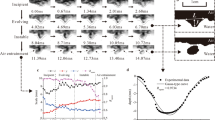Abstract
In this work, theoretical development of void fraction effect over wave energy dissipation and wave setup in a surf zone is made. The formulation incorporates simple energy dissipation model, energy balance equation, and momentum balance equation in air-water mixture fields. The important quantities, such as the energy flux, the radiation stress, the energy dissipation, and the wave setup, are computed and the role of the individual terms in the governing equations is discussed. Void fraction effect in the estimated energy flux in energy balance equation shows to be less dominating over the others. Finally, the void fraction effects for wave height and wave setup are calculated, which demonstrates a good agreement with the experimental results.










Similar content being viewed by others
References
Melville WK, Rapp RJ (1985) Momentum flux in breaking waves. Nature 317:514–516
Horikawa K, Kuo CT (1966) A study on wave transformation inside surf zone. Proc 10th Coastal Eng Conf 1:217–233
Fuhrboter A (1970) Air entrainment and energy dissipation in breakers. Proc ICCE 1:391–398
Thorpe S (1982) On the clouds of bubbles formed by breaking wind waves in deep water, and their role in air-sea gas transfer. Philos Trans R Soc London, Ser A 304:155–210
Hwung HH, Chyan JM, Chung YC (1992) Energy dissipation and air bubbles mixing inside surf zone. Proc 23rd ICCE, ASCE, 308–321
Cox D, Shin S (2003) Laboratory measurements of void fraction and turbulence in the bore region of surf zone waves. J Eng Mech 129(10):1197–1205
Mori N, Suzuki T, Kakuno S (2007) Experimental study of air bubbles and turbulence characteristics in the surf zone. J Geophys Res 112:C05014
Hoque A, Aoki S (2008) Air entrainment and associated energy dissipation in steady and unsteady plunging jets at free surface. Appl Ocean Res 30:37–45
Hoque A (2002) Air bubble entrainment by breaking waves and associated energy dissipation. Toyohashi University of Technology, Japan, p 151
Dally WR, Dean RG, Dalrymple RA (1985) Wave height variation across beaches of arbitrary profile. J Geophys Res 90:11917–11927
Swift RH (1993) A simplified model for wave height and set-up in the surf zone. Coast Eng 19:189–206
Stive MJF (1984) Energy dissipation in waves breaking on gentle slopes. Coast Eng 8:99–127
Lamarre E, Melville WK (1991) Air entrainment and dissipation in breaking waves. Nature 351:469–472
Rapp RJ, Melville WK (1990) Laboratory measurements of deep water breaking waves. Philos Trans R Soc 331:735–800
Peregrine D (2003) Water wave impact on walls. Annu Rev Fluid Mech 35:23–43
Loewen M, O’Dor M, Skafel M (1996) Bubbles entrained by mechanically generated breaking waves. J Geophys Res 101:20759–20769
Wu J (1998) Bubbles in the near-surface ocean: a general description. J Geophys Res 93:587–590
Hoque A, Aoki SI (2005) Distributions of void fraction under breaking waves in the surf zone. Ocean Eng 32(14):1829–1840
Wood IR (1991) Air entrainment in free-surface flows, IAHR hydraulic structures design manual no. 4, hydraulic design considerations. Balkema, Rotterdam, p 149
Chanson H (1997) Air bubble entrainment in free-surface turbulent shear flows, vol 348. Academic Press
Chanson H, Aoki SI, Hoque A (2004) Physical modelling and similitude of air bubble entrainment at vertical circular plunging jets. Chem Eng Sci 59(4):747–758
Hoque A, Aoki S (2014) Wave energy dissipation and wave setup caused by entrained air bubbles in plunging wave breaking. J Waterw Port Coast Ocean Eng 140:04014020–1–04014020–9
Hansen JB, Svendsen IA (1984) A theoretical and experimental study of undertow. Proc. 19th coastal Eng. Conf.: 2246–2262
Bowen AJ, Inman DL, Simmons VP (1968) Wave set-down and set-up. J Geophys Res 73(8):2569–2577
Stive MJF, Wind HG (1982) A study of radiation stress and set-up in the near shore region. Coast Eng 6:1–26
Svendsen IA (1984) Wave heights and set-up in surf zone. Coast Eng 8:303–329
Acknowledgments
The first author would like to acknowledge the financial support provided by the Bangladesh University Grand Commission within the Research Project Program. The authors also acknowledge the helpful comments of two referees.
Author information
Authors and Affiliations
Corresponding author
Additional information
Responsible Editor: Bruno Castelle
Rights and permissions
About this article
Cite this article
Hoque, A., Hossain, N., Ali, S. et al. Wave breaking and bubble formation associate energy dissipation and wave setup. Ocean Dynamics 69, 913–923 (2019). https://doi.org/10.1007/s10236-019-01279-x
Received:
Accepted:
Published:
Issue Date:
DOI: https://doi.org/10.1007/s10236-019-01279-x




